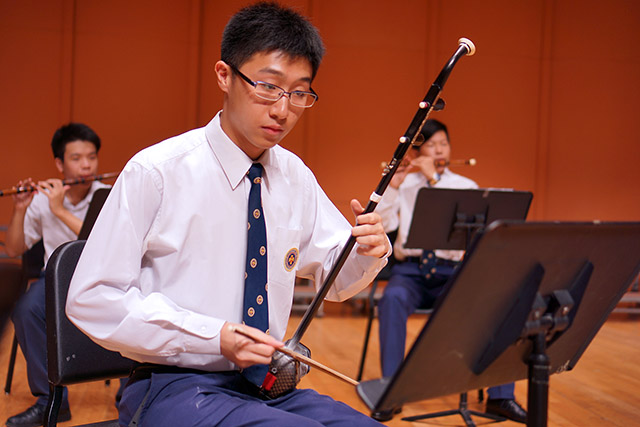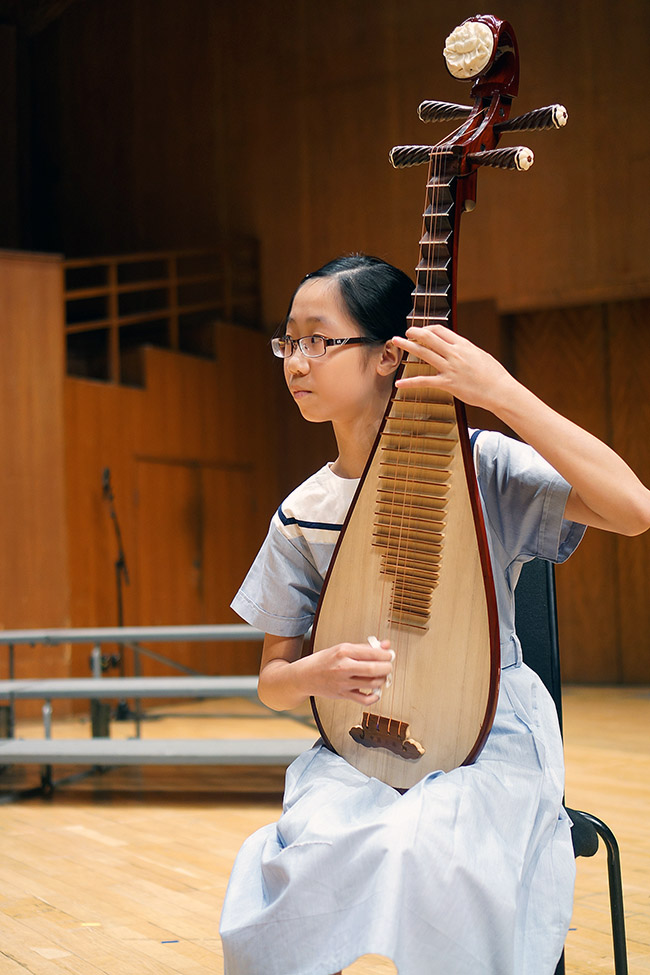The following video is a performance of the song In that Faraway Place by the SKH Lam Woo Memorial Secondary School Chinese Orchestra. The work features a lot of solos, so it can serve as a good introduction to the musical instruments traditionally used in a Chinese Orchestra. If you view the video using YouTube’s caption function (click the CC icon on the bottom), subtitles will appear describing the featured instruments and some of the playing techniques used.
The following instruments are included in the orchestra (I took the photos at rehearsals in 2013 and 2014):
Bowed string Instruments: erhu, zhonghu, gaohu (the huqin family of instruments)
The erhu (二胡) is a two-stringed spiked fiddle. It is descended from an instrument of the Xi people who lived in the Mongolian steppes. It has a wide range of sounds, but it is best known for its melancholy timbre. The material covering the hexagonal resonator box at the bottom of the instrument is python skin, a government-regulated material. Newly-produced erhu must be made using only farmed pythons.
The zhonghu (中胡) is a larger and lower-pitched version of the instrument. There is also the gaohu (高胡)—which is slightly smaller, has a higher pitch, has a round resonator box and is held between the knees. You can see a gaohu being played at 3:03 in the video. There is a very large bass version called the gehu (革胡) that was developed in the 20th century, but this instrument is quite rare. In this Chinese orchestra, cellos and double basses are used in place of the gehu.












Chinese plucked string instruments: liuqin, pipa, ruan, daruan
The pipa (琵琶), a four-stringed pear-shaped plucked lute with frets, is one of the most popular Chinese instruments. It is descended from instruments from Central and West Asia and dates back at least a thousand years (the exact origins are unclear because the term ‘pipa’ used to refer to a large range of plucked chordophones). It can be used to play a wide range of textures from gentle melodies to rhythmic accompaniment to frenzied soundscapes.













The liuqin (柳琴), also known as the liliuqin (柳葉琴, which means ‘willow-leaf-shaped instrument’) is like a much smaller version of the pipa. The front is made of tong wood while the back is made of red sandalwood. It has three to five strings, with four strings between the most common number. While the pipa is held almost vertically, the liuqin is held diagonally across the body.

Liuqin



The ruan (阮) is a plucked lute with a circular body and four strings. Modern ruan have 24 frets and use steel strings. Ruan come in a variety of sizes:
- gaoyinruan (高音阮, literally meaning ‘high-pitched ruan’),
- xiaoruan (小阮 or ‘small ruan’),
- zhongruan (中阮 or ‘medium ruan’),
- daruan (大阮 or ‘large ruan’)
- diyinruan (低音阮 or ‘low-pitched ruan’)
The orchestra in the video has zhongruan and daruan.
Earlier versions of the the ruan existed in the Qin dynasty (more than 2,000 years ago). The performers in the orchestra here are using plectra (like guitar picks), but they can also attach acrylic false nails to their fingers (like pipa players do).




Wind instruments: dizi, suona, sheng
The dizi is a Chinese transverse flute. Most dizi are made of bamboo. They come in a wide range of sizes. The smallest have a piercing high-pitched timbre while the largest have a warm, deep sound. The dizi typically has six finger-holes, and it also has a hole between the blow-hole and finger-holes that is covered by a thin membrane. This extra hole gives the instrument its bright and buzzy timbre. As there are only six holes, that means the number of notes that can be played is quite limited. Therefore, if a song changes key, a dizi player often needs to switch to another flute to suit the new key.




The suona (唢呐) is a double-reed horn that sounds like a particularly strident cross between an oboe (the double-reed part) and a trumpet (the horn part). It has an amazingly piercing timbre. The suona is descended from a instrument called the surna, which comes from the area which is now Iran. It appeared in China around the 3rd century.


The sheng (笙) is an unusual instrument. It is a free-reed aerophone (i.e., the sound is produced by blowing air past a vibrating reed in a frame) with several pipes. It is a polyphonic instrument (meaning it can play more than one note at the same time). It is often used as a kind of harmony instrument, but is also used for melodies. Its sound is something like a cross between bagpipes and a pipe organ. A sheng typically has between 32 and 36 reeds. There are two main types—traditional (in which holes are covered with fingers) and keyed (in which buttons and levers are used to close the holes)—and five main sizes. There is also a keyboard sheng in which a keyboard replaces the buttons and levers.




Guzheng
The guzheng (古箏), or simply ‘zheng’ is a plucked zither that commonly has 21, 25, or 26 nylon-coated steel strings. Its soundboard is made from Paulownia wood and is about 1.6 meters (64 inches) long. An interesting feature of the instrument is that it has movable bridges that allow the performer to change the pitch of each string so that the instrument can play in different keys (this webpage has diagrams showing how to tune the strings: guzhengalive.com/guzheng-tuning). Another purpose of the bridges is that they allow the performer to pluck a string on the right side of the bridge while manipulating the same string on the left side of the bridge to produce effects like vibrato, pitch bends and tremolo. The strings can be plucked using one’s fingers (as the players in these photos are doing), but guzheng players can also wear false nails made from materials such as plastic, resin, tortoiseshell, or ivory on up to four fingers of one or both hands.
The zheng is one of the oldest instruments in the orchestra, with archaeologists discovering remnants of zithers dating back to the Warring States period (475–221 BC). It is an antecedent of instruments like the koto of Japan and the gayageum of Korea.



The guzheng is my favorite Chinese musical instrument. I like it best with gentle songs, but because there are such a wide array of techniques that can be used, the instrument is also suitable for dramatic pieces. Here is one of the school’s students performing a classic martial work, Ambush on All Sides:
Yangqin
The Yangin is a hammered dulcimer. The strings are hit with light bamboo hammers with rubber tips. Different styles of tips can create different timbres. Modern yangqin usually have 144 strings and four or five bridges. The strings are grouped together with up to five strings per course to give a firmer, stronger sound.
The instruments origins are unclear. Some musicologists argue that it is derived from the Iranian santur, some argue that it is derived from European dulcimers.







Western strings: cello and bass
The school’s Chinese orchestra doesn’t have any gehu (the lowest-pitched erhu) or diyinruan (the largest pitched ruan). Instead these parts are played by cellos and double basses. The mostly likely reason is that the school has a limited number of students and also has a symphonic band and orchestra (as well as a few choirs). Thus, it is easier and more cost effective to have some of the cellists and bassist play in all the large instrumental ensembles.


Percussion
The percussion sections includes western instruments—such as tambourine, sleigh bells, woodblocks, timpani, snare drum, hand drum, xylophone and claves—as well as traditional Chinese percussion instruments.


The ensemble
In the following picture, you can see how the instruments are arranged:





More information
For more information about the individual instruments, you can refer to the following websites:
- List of Chinese Musical Instruments: en.wikipedia.org/wiki/List_of_Chinese_musical_instruments
- String Instruments from China: www.philmultic.com/home/instruments/
Information about the video-recording
Conductor: Yim Kin-man 嚴健民
Composer: Wang Luo-bin (王洛宾)
Orchestral Arrangment: by Gu Guan-ren (顧冠仁)
The video was taken during a rehearsal before the Hong Kong Schools Music Festival Competition (the orchestra put on an even better performance that day, winning the competition). Two students (Teresa Ng and Maggie Lai) helped me take the footage and we recorded three takes.
~ photos, text and video by longzijun
